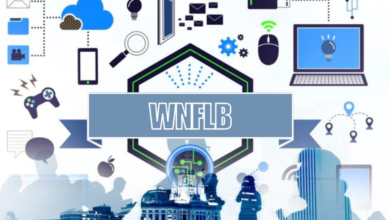QXEFV: Unlocking Its Potential in Today’s Digital Landscape

Introduction to QXEFV and its meaning
In a world where digital transformation is the norm, QXEFV has emerged as a beacon of innovation. But what exactly is QXEFV? It’s more than just an acronym; it represents the next wave in technology that promises to reshape our online experiences and interactions. As businesses scramble to adapt, understanding this concept has never been more essential.
Imagine being able to unlock new opportunities with tools that enhance connectivity, efficiency, and security. That’s what QXEFV aims to deliver. From small startups to giant corporations, everyone is looking for ways to harness its potential. Join us on this journey through its history, advantages and disadvantages, and how it’s already making waves in today’s digital landscape!
History and Evolution of QXEFV
QXEFV emerged in the early 2020s, born from a need for more secure digital frameworks. Initially, it was primarily used by tech enthusiasts and developers seeking innovative ways to enhance data security.
As awareness grew, so did its applications. Early adopters began integrating QXEFV into various sectors including finance and healthcare. This versatility showcased its potential beyond mere technical jargon.
Over time, advancements in AI and machine learning propelled QXEFV’s capabilities further. Its adaptability made it attractive to companies looking for competitive edges in an increasingly online world.
The transitions didn’t stop there; updates continuously refined its functionality. Each iteration brought enhancements that appealed to businesses aiming for efficiency without compromising safety standards.
Today, QXEFV stands as a testament to how rapidly technology can evolve when driven by necessity and innovation.
Advantages and Disadvantages of using QXEFV in the Digital World
QXEFV brings several advantages that can enhance digital operations. Its ability to streamline processes allows for faster decision-making and improved efficiency. Businesses often experience increased productivity, as tasks become automated or simplified.
However, challenges accompany these benefits. The complexity of integrating QXEFV into existing systems may lead to significant upfront costs. Organizations might face a steep learning curve, which can temporarily disrupt workflow.
Additionally, reliance on QXEFV raises concerns about security vulnerabilities. Data breaches remain a critical threat in the digital landscape. This potential risk makes some businesses hesitant to adopt the technology fully.
Moreover, not all sectors are ready for such advancements. Smaller companies might find it challenging to keep pace with larger competitors who leverage QXEFV’s capabilities more effectively. Balancing innovation with practicality is essential in this evolving environment.
How Companies are Utilizing QXEFV
Companies are increasingly integrating QXEFV into their operations to enhance efficiency. By leveraging its capabilities, businesses streamline processes that once consumed significant time and resources.
In the marketing realm, firms utilize QXEFV for data analysis. It helps identify consumer behavior patterns, enabling targeted campaigns that resonate with specific audiences.
Furthermore, tech companies employ QXEFV in software development. The technology accelerates coding processes and reduces bugs, resulting in faster deployment times.
Financial institutions have also embraced QXEFV for risk assessment. It allows them to analyze vast datasets quickly, improving decision-making related to investments and lending practices.
On the customer service front, chatbots powered by QXEFV provide instant support. They address client inquiries efficiently while freeing human agents for more complex issues.
Each of these applications showcases how versatile and impactful QXEFV can be across various sectors.
The Future of QXEFV in Technology
The future of QXEFV in technology is both exciting and unpredictable. As advancements continue, the integration of QXEFV could revolutionize how we interact with digital platforms.
Emerging technologies like artificial intelligence and blockchain are on the horizon. They offer a unique synergy with QXEFV’s capabilities. Enhanced security protocols promise to safeguard data better than ever before.
Additionally, industries such as finance and healthcare are poised for transformation. With real-time analytics powered by QXEFV, businesses can make informed decisions rapidly.
As companies explore new applications, we may see a rise in personalized user experiences. This can lead to greater customer satisfaction and loyalty.
Innovations will likely pave the way for increased adoption across various sectors—showing that the potential reach of QXEFV knows no bounds. The true impact remains to be seen as more organizations embrace this emerging trend.
Potential Impact on Society and Privacy Concerns
The rise of QXEFV is reshaping societal interactions and how we perceive privacy. As organizations increasingly adopt this technology, individuals may face challenges in maintaining control over their personal data.
Users often unknowingly share more information than intended. This raises questions about consent and awareness in digital spaces. The potential for misuse looms large, as malicious entities seek to exploit vulnerabilities within these systems.
Moreover, the balance between innovation and security becomes fragile. Companies must prioritize ethical practices while harnessing QXEFV’s capabilities. Transparency is key; users deserve clarity on how their data is collected and utilized.
Society must engage in discussions about the implications of such advancements. Public awareness campaigns can empower individuals to make informed choices regarding their digital footprints. In a rapidly evolving landscape, vigilance and responsibility will be crucial for safeguarding privacy rights.
Conclusion: Is QXEFV the Future or a Passing Trend?
The question of whether QXEFV is a lasting innovation or merely a fleeting trend lingers in the minds of many. As it stands, this technology holds significant potential to reshape industries and elevate user experiences. Companies that have embraced QXEFV are already reaping its benefits, showcasing increased efficiency and improved outcomes.
Yet, with great power comes responsibility. Concerns regarding privacy and data security continue to accompany these advancements. Society must navigate this landscape carefully, weighing progress against ethical considerations.
As we observe its evolution and adoption rates, it’s clear that QXEFV could play an essential role in our digital future. Whether it will become an integral part of daily life remains to be seen. For now, organizations must remain vigilant as they harness its capabilities while addressing the challenges that come along with such powerful tools. The journey has just begun; only time will reveal where QXEFV ultimately leads us all.



